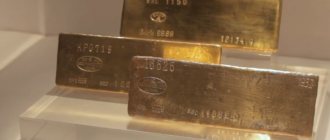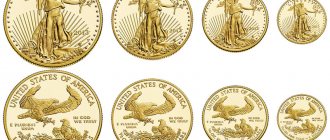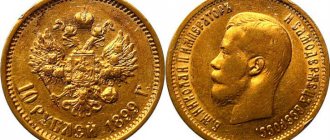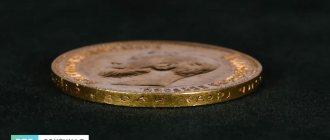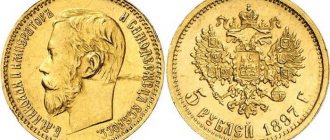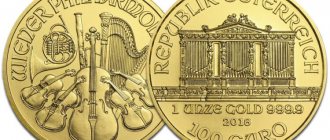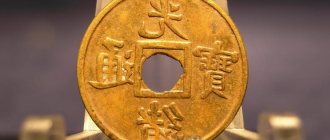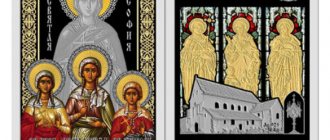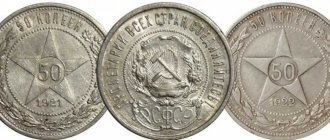In Russian numismatic terms, chervonets refers to a specific type of gold coin, whereas in colloquial speech this name often accompanied any large-sized gold coin. Initially, it was only about foreign coins made of high-grade (“red”) gold. The earliest example of domestic coinage dates back to the reign of Ivan the Third. In different eras, the market value of a chervonets reached three and a half rubles in silver. Under Peter the Great, the chervonets was a 980 gold coin weighing 3.47 grams. In 1718, it was replaced by the gold two-ruble note (781 samples weighing 4.1 grams). Chervonets were also minted under subsequent rulers. Their obverse was always decorated with the face of the emperor or empress. But then the revolution happened, and a peasant suddenly appeared on a gold coin during the sowing season.
Golden chervonets “Sower”
To get an idea of the reasons for the appearance of chervonets in the country of the Soviets, one should go back to the pre-revolutionary era. Since 1897, Nicholas II issued gold coins of 900 standard (15 and 7.5 rubles were minted only in the first year of the period of gold monometallism). The first gold tens of this type appeared in 1898 and did not yet bear the nickname “chervonets”. There was at least 7.74 grams of pure metal in ten. Coins were not only used in calculations, but also served as an excellent store of value.
After the revolution, the Council of People's Commissars faced the urgent task of stabilizing the financial system, destroyed by the civil war. “Our economic and financial policy is decisively oriented towards the restoration of the gold backing of money,” read the resolution of the 11th Congress of the RCP (b). The name of the monetary unit was chosen from “hryvnia”, “chervonets” and “rubles”. In colloquial speech, the word “rubles” meant a silver ruble, and “hryvnia” was the recent monetary unit of the UPR that ceased to exist. Of the three possible options, there was only one left.
There has been no talk about minting gold coins yet. The State Bank received the right to issue banknotes in gold terms. The largest was 25 chervonets, which was equivalent to 193.5 grams of precious metal. Now the money turnover of the RSFSR was supported not only by Sovznaki, but also by a new currency backed by gold.
"Historical" series
On September 13, 1988, the first issue of coins made of precious metals of the Historical Series “ 1000th anniversary of ancient Russian coinage, literature, architecture, baptism ” was released. Their reverses reflect the era of Kievan Rus of the 10th–11th centuries, depicted in architectural monuments, ancient Russian literature, and the first coins of Vladimir Svyatoslavovich.
Gold, silver, platinum and, for the first time, palladium were used to make coins in this series.
The coin of this series of 50 rubles from 1988 “St. Sophia Cathedral in Novgorod” was minted on the MMD with a circulation of 25,000 pieces as proof.
The coin is made of 900-carat gold, the weight of pure metal is 7.78 grams, the diameter is 22.6 mm.
100 rubles of 1988 “Zlatnik of Vladimir” were minted on MMD with a circulation of 14,000 pieces as proof.
The coin is made of 900-carat gold, the weight of pure metal is 15.55 grams, the diameter is 30 mm.
Subsequent issues of the Historical Series were dedicated to the eras of Ivan III, Alexander Nevsky, Dmitry Donskoy, Peter I, Catherine II, and other historical periods of Russia.
On August 31, 1989, the series “500th anniversary of the unified Russian state” , published until 1991. It included six commemorative gold coins.
coin of 1989 “Assumption Cathedral in Moscow” was minted on the MMD with a circulation of 25,000 pieces as proof.
The denomination coin is made of 900-carat gold, the weight of pure metal is 7.78 grams, the diameter is 22.6 mm.
100 rubles of 1989 “State Seal of Ivan III” were minted on the MMD with a circulation of 14,000 pieces as proof.
The coin is made of 900-carat gold, the weight of pure metal is 15.55 grams, the diameter is 30 mm.
coin of 1990 “Monument to Peter I in St. Petersburg” was minted on the MMD with a circulation of 14,000 pieces as proof.
The coin is made of 900-carat gold, the weight of pure metal is 15.55 grams, the diameter is 30 mm.
50 rubles 1990 “Church of the Archangel Gabriel in Moscow” were minted on MMD with a circulation of 25,000 pieces as proof.
The coin is made of 900-carat gold, the weight of pure metal is 7.78 grams, the diameter is 22.6 mm.
100 rubles 1991 “L.N. Tolstoy (1828-1910) – Russian writer” were minted on MMD with a circulation of 14,000 pieces as proof.
The coin is made of 900-carat gold, the weight of pure metal is 15.55 grams, the diameter is 30 mm.
50 rubles 1991 “St. Isaac’s Cathedral in St. Petersburg” - minted on MMD with a circulation of 25,000 pieces as proof.
The coin is made of 900-carat gold, the weight of pure metal is 7.78 grams, the diameter is 22.6 mm.
It was planned to sell 10% of the Historical Series circulation in the USSR for rubles. For gold coins with a face value of 50 rubles, the price was set at 710 rubles.
Chervonets “Sower” 1923
It turned out that the tsarist gold tens still enjoy great trust among the population, who prefer to keep their savings not in banknotes that were compromised during the Civil War, but in metal. Therefore, after the first issue of paper chervonets, a decision was made to provide their coin counterpart. The royal ten was taken as a basis (900 standard, 7.74 grams of pure metal). The obverse bears the coat of arms of the RSFSR. Through the efforts of the medalist of the Petrograd Mint A.F. Vasyutinsky, the reverse was decorated with the image of a peasant sower.
The model for the bas-relief was the famous bust sculpture of I.D. Shadra “The Sower” (Tretyakov Gallery). Shadr’s work turned out to be closely connected with the life of the Soviet country. The compositions “Peasant”, “Red Army Soldier”, “Worker” were used in the design of standard issues of postage stamps. And based on the famous “Girl with an Oar,” they immediately imagine the park sculpture of the USSR of the pre-war period.
The first gold chervonets came out from the stamp pair on August 27, 1923. For the period 1923-1924. According to documents, the Petrograd Mint issued 2,751,300 coins. Other sources indicate that only 100,000 copies of the Sowers were minted. The confusion is due to the fact that most of the circulation was subsequently melted down to produce analogues of the five- and ten-ruble coins of Nicholas II . Since, along with the “Sowers,” gold coins from the tsarist era continued to circulate in the domestic market, dozens of Nicholas II also began to be called “chervonets.”
The transition to issuing banknotes no longer from the RSFSR, but from the USSR, raised the question of changing the coat of arms on the obverse. There are samples with the date “1925” and the coat of arms of the USSR. None of the five known examples are present on the numismatic market. Two copies are kept in the Pushkin Museum. Three more coins are on display at the Goznak Museum. Since the main purpose of the gold issue was international settlements, and not domestic turnover, the need for the issue disappeared. The means of payment have changed in the world market. Now gold bullion and stable currencies (US dollar, British pound sterling and Swiss franc) dominated there.
Tsar's chervonets
The Soviet chervonets is identical in its characteristics to the Tsar's chervonets - 10 rubles 1897 (imperial), from the time of Nicholas II:
- uncirculated quality (AC);
- pure gold content 7.742 g;
- total weight 8.603(±0.08) g;
- 900 gold;
- diameter: 22.60 (+10 -0.15) mm;
- thickness 1.70(+0.05 -0.15) mm
The difference between the two coins is in appearance. On the imperial coin there is the coat of arms of the Russian Empire and the profile of Nicholas II with the inscription: “Nicholas II Emperor and Autocrat of All Rus'”; on the Soviet coin there is the coat of arms of the RSFSR with the inscription: “PROLETARIANS OF ALL COUNTRIES, UNITE!” and the figure of a peasant - sower against the background of factories, a plow and the sun.
The author of the sketch for the Soviet chervonets was Anton Fedorovich Vasyutinsky (1858-1935), a famous medalist artist. What is noteworthy is that he was a famous author of both royal coins and medals and Soviet ones.
The approximate price of coins issued in 1923 is 80,000 - 130,000 rubles. They are quite rare and are of interest to numismatists.
Sower Coin 1980
The minting of the “Sower” began again only in 1975. The coins, right down to the coat of arms of the RSFSR, copy the 1923 copy. Only the initials of Peter Latyshev disappeared from the edge, and the date corresponds to the period of minting. In 1977, both mints were already working on the production of gold coins. From this moment on, the edge inscription is supplemented with the designation “(MMD)” or “(LMD)”. Internal circulation of chervonets was not expected. Residents of the USSR did not have access to purchase them. Presumably the reason for the resumption of minting is the sale to foreign tourists in the pre-Olympic period and at the Moscow Olympics itself.
Therefore, among ordinary chervonets, one can distinguish copies from 1980 from both yards as “Proof” (matte relief on a mirror field). The coinage for collectors was issued in a large circulation - 100,000 coins. It was assumed that foreign buyers would buy not only coins with Olympic symbols, but also collectible chervonets. Note that the “Sowers” with the date “1980” in the usual version were minted 10 times more.
Issues of the Golden Sower 1975 and subsequent years
The decision in 1974 to hold the first Olympic Games on the territory of the Soviet Union was a great joy, but also imposed great responsibility on the entire country. Since 1976, large-scale construction of Olympic infrastructure facilities has begun.
Before such a major event as the upcoming Olympics, the issue of the golden chervonets Sower
. This was mainly done to raise the country's prestige. The coins were going to be used for souvenir purposes and for foreign trade purchases. The cost of a new Sower in 1980 ranged from 500 to 700 Soviet rubles and just covered the cost of production and the price of the gold used.
The release of the new “Sower” continued in the period 1975-1982. A total of 6,565,000 coins were produced, which completely copied the chervonets of the 1923 model. Only the minting date was changed, which corresponded to the actual year of issue. A special batch of 1980 was also produced using the “proof” technology, amounting to 100,000 pieces.
Never having entered full circulation, the gold chervonets Sower
today are
investment
gold coins.
Many numismatists use it as a profitable investment, since the price of each piece slowly but surely grows over the years. The Russian bank successfully sells the remainder of Sower's
to this day. The cost of these coins can reach up to 25,000 rubles, and for rare copies - up to 45,000.
Chervonets "Sower" 1981
The 1981 chervonets are also of interest among collectors. But here the lion's share of attention goes to the products of the Leningrad Mint. Until recently, a coin with the letters LMD on the edge was considered incredibly rare. Now the prices for it have decreased somewhat, but it still costs at least twice as much as the same coin from the Moscow court.
Moscow copies of 1981 several years ago caused fierce controversy in the collecting community. Chervonets purchased from one of the leading Russian banks were presented for discussion. To the untrained eye, they looked like ordinary coins. However, experts noticed discrepancies in small details and features of the coinage. The gold in them was slightly lower than the declared standard. The origin of the strange “Sowers” remains unclear. It has been suggested that the shipment of gold coins legalized the mining of unofficial miners. Similar chervonets were also seen with the date “1980”.
The Sower as the salvation of the state's financial system
In the first years of Soviet power, depreciated paper kerenkas were used to cover toilets and heat potbelly stoves. The young republic needed its own money. Gold and silver royal coins could no longer be used in official circulation. After the reign of Nicholas II, the Provisional Government of Kerensky, the First World War and civil strife, the financial system of the state fell into complete decline.
Important! To restore monetary circulation, the Soviet government carried out a reform of 1922-1924, an integral part of which was the minting of new chervonets from gold, intended for transactions both within the country and abroad.
Chervonets sower began to be produced in Petrograd. Coins were minted according to pre-revolutionary standards in order to restore positions in payments and make the new banknote understandable to foreign banks. The 1923 Sower coin was produced in the amount of 2 million 751 thousand pieces. The precious metal in the coin was 900 fine, the weight of a gold chervonets was 8.6 grams, and the diameter was 22.5 mm.
The most expensive "Sowers"
- Chervonets 1925, trial (copper): 5,000,000 rubles
- Chervonets 1923: 200,000 rubles (approximate price for the first half of 2021)
- Chervonets 1980 LMD (Proof): 90,000 - 140,000 rubles (approximate price range for 2021)
- Chervonets 1981 LMD: 50,000 - 70,000 rubles (approximate price range for 2021)
- Chervonets 1980 MMD (Proof): 30,000 - 37,000 rubles (approximate price range for 2021)
Financial and credit organizations buy and sell gold, focusing not on the date, but on the cost of the metal and the safety of the coin. But in a collecting environment, the yard and the date are sometimes of great importance. Therefore, buyers of gold “Sowers” carefully examine the coin before purchasing, hoping to find rare specimens among ordinary coins. Theoretically, even 1923 may be among the “Sowers” put up for sale. But in practice, no one has yet boasted of such a find.
"Russian ballet"
In 1989, a series of commemorative coins “Russian Ballet” was launched, which enjoyed enormous popularity abroad. On October 1, 1991, seven gold coins from this series were released.
Three gold coins from the Russian Ballet series
100 rubles 1991 “Russian Ballet” as proof. Minted on LMD in an edition of 1,500 pieces from 999-carat gold, weight 15.55 grams, diameter 30 mm.
100 rubles 1991 "Russian Ballet" as UNC with a denomination of 100 rubles. Minted on LMD in an edition of 1,200 pieces from 585-carat gold, pure metal weight - 15.55 grams, diameter 35 mm.
50 rubles 1991 “Russian Ballet” as proof. Minted on LMD in an edition of 1,500 pieces from 999-carat gold, weight - 7.78 grams, diameter 22.6 mm.
50 rubles 1991 “Russian Ballet” as UNC. Minted on LMD in an edition of 2,400 pieces from 585-carat gold, pure metal weight - 7.78 grams, diameter 28.6 mm.
25 rubles 1991 “Russian Ballet” as proof. Minted on LMD in an edition of 1,500 pieces from 999-carat gold, weight - 3.11 grams, diameter 16 mm.
25 rubles 1991 “Russian Ballet” as UNC. Minted on LMD in an edition of 5,000 pieces from 585-carat gold, pure metal weight - 3.11 grams, diameter 21 mm.
10 rubles 1991 "Russian Ballet" as UNC with a denomination of 10 rubles. Minted on LMD in an edition of 8,000 pieces from 585-carat gold, pure metal weight - 1.555 grams, diameter 17 mm.
Investment coin “Sower”
After the collapse of the USSR, the golden “Sowers” found a second life. The Bank of Russia decided to use the reserves of chervonets as coins for investment and organized their sale with subsequent purchase through a network of credit institutions. From this moment on, the cost of the “Sower” directly depends on stock exchange prices for gold. The popularity of the “Sowers” turned out to be so high that by the middle of the first decade of the 21st century, the Bank of Russia was faced with a shortage of chervonets, and therefore the issue of gold “St. George the Pobedonostsev” . Now “Sowers” are actively traded along with other domestic and foreign investment coins. But the previously disassembled copies of “Proof” from 1980 and 1981 do not fall into this group, since according to Russian tax legislation, coins made of precious metals issued in normal quality using minting using automatic equipment can be called investment coins.
Soviet Diamond The Rise and Fall of the Red Chervonets
There is an extremely interesting period in the history of Russian finance, which, despite its apparent fame, has clearly not been studied enough. We are talking about the introduction of the golden chervonets in 1924. Almost no one remembers now who prepared this reform, which stopped hyperinflation and revived the Russian economy.
“At the People's Commissariat of Finance, a constant large expense item is the purchase of new light bulbs. The population has an acute shortage of light bulbs, and employees of the People's Commissariat unscrew them and take them home. People's Commissar Sokolnikov finds an ingenious solution: the plant supplying light bulbs is ordered to engrave on each light bulb: “stolen from Narkomfin,” recalled Stalin’s former secretary Boris Bazhanov. Who is this person who so cleverly solved the eternal Russian problem?
Girsh Yankelevich Brilliant (aka Grigory Yakovlevich Sokolnikov) was born in the city of Romny, Poltava province in 1888 in the family of a doctor on the Libavo-Romensky railway, collegiate adviser Yankel Moiseevich Brilliant. Soon after the birth of their son, the family moved to Moscow, the father acquired a pharmacy on Trubnaya Square (this building has still been preserved). Girsh-Grigory graduates with honors from the 5th Moscow Gymnasium (Osip Brik is in the same class with him, and Boris Pasternak is two classes younger) and enters the Faculty of Law of Moscow University. However, he failed to obtain higher education in Russia.
In 1905, Grigory joined the Russian Social Democratic Labor Party (RSDLP), carried out underground work in Moscow, and took an active part in the December Uprising. Despite his young age (he is only 17 years old), he becomes a member of the Sokolniki Revolutionary Committee of the party and takes the party pseudonym Sokolnikov. In the fall of 1907, he was arrested and after a year and a half of investigation, according to the verdict of the Moscow Court of Justice, he was exiled to Siberia for eternal settlement. In the village of Rybnoye, Yenisei province, Sokolnikov stayed for a short time. Six weeks after arriving at the settlement, he fled abroad and arrived in France in the fall of 1909.
Grigory Sokolnikov
Photo:
In addition to party activities, Sokolnikov does not forget about education while in exile. Having entered the law faculty of the Sorbonne, he graduated in 1914 and began scientific work in doctoral studies at the Faculty of Economics. In April 1917, the former Brilliant, together with the former Ulyanov, arrived in Petrograd.
Immediately after the October Revolution, in November-December 1917, 29-year-old Sokolnikov led the nationalization and reorganization of private banks; from December 30, 1917, he headed the Commissariat of Former Private Banks, which soon became part of the People's Commissariat of Finance (Narkomfin). Participates in negotiations with Germany - his signature is on the Brest-Litovsk Peace Treaty. The merit, frankly speaking, is dubious. During the Civil War he was a member of the Revolutionary Military Councils at various levels, commander of the 8th Army, commander of the Turkestan Front.
It was Sokolnikov who was one of the initiators of recruiting the so-called military experts - officers of the old imperial army - to work in the ranks of the Red Army. He sharply opposed “decossackization.” In Turkestan in the spring of 1921, Sokolnikov, who was struggling not only with the Basmachi, but also with economic problems in the region, decided to completely withdraw local banknotes (the so-called turkbons) from circulation, exchanging them at a rate of 10 to 1 for Soviet rubles (sovznaki). Thus, not only was the unification of monetary circulation achieved, but also the volume of unsecured money supply in Turkestan was seriously reduced.
In the fall of 1921, Sokolnikov was appointed a member of the Narkomfin board, in the spring of 1922 - deputy people's commissar of finance, in the fall of the same year - people's commissar of finance of the RSFSR, and in July 1923, after the formation of the USSR Narkomfin, he headed this institution. The situation in the country was extremely difficult; by the autumn of 1921, the ruble had depreciated tens of thousands of times compared to 1914. The Soviet government involved a number of financiers and economists who had experience working in financial institutions of pre-revolutionary Russia to solve the problems that arose. However, this measure turned out to be very late - due to the poor harvest of 1921, the supply of food to the market decreased sharply. As a result, prices increased 50 times from October 1921 to May 1922.
The rise in food prices forced the government to increase wages and, therefore, turn on the printing press. Excessive issue of Sovznak led to a sharp increase in inflation, which put an end to economic recovery after the Civil War. Sokolnikov reacted extremely harshly to these panicky actions of the Soviet government: “If we have on the wall near the Iveron Chapel: “Religion is the opium of the people,” then I would suggest hanging a sign near the Supreme Economic Council: “Emission is the opium of the national economy.”
In the fall of 1921, by decrees of the Council of People's Commissars (SNK) and the All-Russian Central Executive Committee (VTsIK), the State Bank of the RSFSR was established, still without emission rights. The first major meeting on the regulation of money circulation was held at Narkomfin with the participation of involved specialists. Most of them were very skeptical about the prospects for the ruble, believing that a stable currency could only emerge as a result of economic recovery. For example, a member of the Narkomfin board, Otto Yulievich Schmidt (later a famous polar explorer), believed that this issue should be returned to no earlier than ten years later. Sokolnikov, remaining in the minority, said that with a falling Soviet sign it was impossible to restore the economy, and therefore it was necessary to look for ways to create a stable currency.
Former banker and former millionaire, and now a simple co-employee, Vladimir Tarnovsky proposed a tough but extremely effective move to Narkomfin. The issue of rapidly depreciating Sovznak bills, covering the budget deficit, must not be stopped. However, in parallel, issue banknotes backed by gold and foreign currency - they will launch commercial circulation. On the one hand, the financial system is stabilizing - people were not limited in Sovznak and the government did not take any confiscation measures. On the other hand, an incentive was created for open commerce and the black market was actually dismantled.
Sokolnikov believed that the State Bank should be given the right to issue its own paper money, called, in contrast to state banknotes (sovznak), “credit notes of the State Bank.” State Bank notes must be secured by gold, precious metals, foreign currency and other valuables and goods owned and pledged by the bank, as well as bills and obligations. The stumbling block was that Tarnovsky thought extremely big and believed that the golden Soviet ruble should be introduced not as a temporary, but as a permanent financial instrument and, in addition, initially position it as a world currency.
Sokolnikov completely sided with Tarnovsky and in the shortest possible time was able to overcome the resistance of professional revolutionaries, who considered money a relic of the capitalist past and a tool for the exploitation of workers. However, the catastrophic situation that developed in the RSFSR clearly explained the difference between Marxist theory and practice.
On July 25, 1922, the decree of the Council of People's Commissars “On granting the State Bank the right to issue bank notes into circulation” was adopted. In October of the same year, the Council of People's Commissars issued a decree “On granting the State Bank the right to issue bank notes.” In December, Soviet chervonets appeared in circulation. There was also a heated debate about the name of the new currency. Fiery revolutionaries wanted to call her “federal.” There were also old regime offers: rubles, hryvnia and chervonets. The population associated the tselkovy with the silver ruble, the hryvnia was compromised during the existence of the UPR, and by chervonetsy everyone understood the gold coin issued during the reign of Nicholas II, so there could be no discrepancies here.
Leonid Yurovsky
Photo:
During the preparation of the reform, one of the main supporters of the introduction of gold circulation, economist Leonid Yurovsky, was appointed deputy head of the currency department, and his area of activity included regulating all monetary policy and developing measures to improve monetary circulation. A word from Stalin’s secretary Boris Bazhanov: “People’s Commissar of Finance Sokolnikov, who is carrying out monetary reform, submits for approval by the Politburo the appointment of Professor Yurovsky as a member of the Narkomfin board and head of the currency department. Yurovsky is not a communist, the Politburo does not know him. One of the members of the Politburo asks: “I hope he is a Marxist?” “What are you talking about,” Sokolnikov hastens to answer, “the currency department, there you don’t have to talk your tongue, but be able to get things done.”
12 days after his appointment, on August 22, Yurovsky was placed under house arrest. Together with his friends Nikolai Berdyaev and Semyon Frank, he had to leave the country, and only Sokolnikov’s intercession saved him from deportation. What was the reason for the arrest? The fact is that Yurovsky, in his article in the journal “Economic Revival,” proposed reducing military spending to reduce the budget deficit. Of course, the vigilant comrade Vladimir Sarabyanov regarded this as a call for the liquidation of the Red Army with understandable consequences for Yurovsky. In 1938, Yurovsky was shot at the Kommunarka training ground. Sarabyanov died of natural causes in 1952 and was buried at the Novodevichy cemetery in Moscow.
Thanks to Sokolnikov’s efforts, in October 1922, Yurovsky was appointed as a representative of Narkomfin on the Council for Issue Affairs at the State Bank. He became the “eyes” of Grigory Yakovlevich, watching the money machine. In December 1922, Yurovsky wrote to Sokolnikov: “Many hands, and some very strong hands, will reach out to the newly operational printing press.” The issue of Sovznak continued to pose a threat to monetary reform. In the first half of 1923, about a third of budget expenditures were financed by emissions. The enraged Sokolnikov, at a meeting of the All-Russian Central Executive Committee, proposed shooting the heads of departments and enterprises who demanded an additional share issue to cover debts on wages and contracts. The Soviet oligarchs escaped with only a slight fright. Nevertheless, in the summer of 1923, the All-Russian Central Executive Committee adopted a resolution according to which, from January 1, 1924, the USSR stopped issuing emissions to cover the deficit.
Unfortunately, it was not possible to implement this resolution, because by the fall, due to hopes for an early socialist revolution in Germany, military spending increased many times over. Their growth was hidden from specialists, the gaps were closed with an additional issue. The reform has stalled. However, the process of forming the foreign exchange market has already been launched. In February 1924, the Soviet government finally stopped the issue and began exchanging Sovznak for paper rubles. The initial rate was set at half a million 1923 Sovznak (or 500 billion old rubles) per one gold chervonets or 10 rubles. Due to an acute shortage of small bills in some regions, the exchange rate was 20-30 percent higher. In April 1924, Sovznak ceased circulation. Formally, the new rubles were not tied to the chervonets, but the actually established rate of 10 rubles per chervonets no longer changed, and the two parallel currencies that existed in the country merged into one.
25 chervonets, 1922
Photo:
The Sokolnikov-Yurovsky-Tarnovsky chervonets corresponded to the pre-revolutionary chervonets and was backed by a quarter of its value in gold, precious metals and foreign currency, and 75 percent by goods and short-term liabilities. In 1925, the Soviet chervonets was officially listed on the stock exchanges of a number of countries in Europe and Asia, and transactions with it were carried out in Great Britain, Germany, the USA and many other countries. At that time it was one of the strongest world currencies, valued higher than the British pound and worth more than 5 US dollars. In May 1924, Zinoviev complained at the XIII Party Congress: “We have accumulated one hundred million in foreign currency in foreign trade - we don’t know what to do with it.”
It is curious that the chervonets as a gold coin, minted in 1922 simultaneously with the issue of the paper chervonets, initially failed on the world market. Foreigners categorically did not want to work with coins decorated with Soviet symbols. Sokolnikov, with a terrible scandal, is pushing for a change in the design of the coins and... gold coins minted in the USSR with a double-headed eagle and the profile of the last tsar are coming to the West.
At the XIV Congress of the All-Union Communist Party (Bolsheviks), VKP(b), in 1925, Sokolnikov was the only one who spoke in favor of removing Stalin from the post of general secretary of the party. His support for Zinoviev, Kamenev and (at that time) Krupskaya cost him the post of People's Commissar of Finance and membership in the Politburo. Saying goodbye to his colleagues at Narkomfin, he said: “Only thanks to the fact that the commissariat and public opinion of employees sufficiently provided the opportunity for the work of specialists in financial science and financial practice to develop, only thanks to this were the advantages that the construction work of NKFin achieved possible.” Grigory Yakovlevich received an honorable resignation in the form of the post of deputy chairman of the USSR State Planning Committee. Two years later, at the XV Party Congress, Sokolnikov opposed the collectivization policy and supported the development of industry within the framework of the NEP.
His further fate was predetermined. On July 26, 1936, Sokolnikov was arrested in the case of the “Parallel Anti-Soviet Trotskyist Center”, expelled from the party, on January 30, 1937, sentenced to 10 years in prison and, according to the official version, on May 21, 1939, he was killed by prisoners in the Verkhneuralsk political isolation ward. According to other sources, on that day he was shot by NKVD officers in the Tobolsk prison. On June 12, 1988, Grigory Yakovlevich Sokolnikov-Brilliant was posthumously rehabilitated by the Plenum of the Supreme Court of the USSR, and on December 16 of the same year he was reinstated into the CPSU.
The gold chervonets in the 1923 design was issued again in 1975 and was minted until 1982 (a total of 3,350,000 coins were issued). Now the Sokolnikov chervonets is legal tender in Russia, one of the main investment coins of the Bank of Russia. Its price as of the beginning of December 2014 is about 22 thousand rubles. This is the best confirmation that the reform of 1922-1924 was the right, albeit extremely tough, decision.
